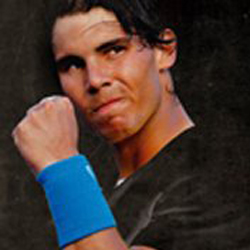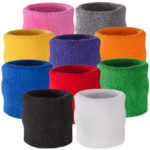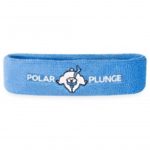When completing any form of exercise, recreational or competitively, it’s imperative that you are equipped with the right clothing and accessories. Aside from making you look better and feel more confident, those products can add comfort, improve performance, and help prevent injuries.
The seemingly small accessories can often have the biggest difference, and sweatbands certainly fall into this category. Sports sweatbands can provide significant help for gym workouts, team sports, and virtually all other exercises. They’re not necessarily something you’ll appreciate when you are equipped – but you certainly will when you’re missing the item, and they should be considered an essential item for casual and serious athletes alike.
The History Of Sweatbands
As a fashion accessory, headbands date back to the ancient Greeks, and are believed to have existed as early as 475 BC. The original headbands took the form of hair wreaths that were used to mark special occasions. While the headpiece has evolved over the centuries, it is still very much a popular fashion item today.
Regarding sports, however, the sweatband that we know and love was designed in the 1940s and popularized by iconic tennis star Fred Perry – who had worked with Tibby Wegner, an Austrian footballer, to invent the world’s first antiperspirant wristband.
Since being introduced in this current guise, the sports sweatband has undergone minimal change. A few simple tweaks have been introduced over the decades, but the fundamentals have remained constant. The only major changes have been to the design; nowadays, you can choose headbands and wristbands in a variety of different colors as well as opting for custom designed pieces.
In addition to helping sports stars, sports sweatbands have often been used as a fashion piece to promote charitable causes. Moreover, the sweatband was a major inspiration for silicone charity wristbands.
The Benefits Of Sports Sweatbands
Sports sweatbands can become the perfect accessory for aesthetic purposes. Whether it’s a wristband or a headband doesn’t matter, they can work wonders for the color coordination. Once again, those benefits can be enjoyed during individual exercises as well as team sports and group activities.
The primary function of the sweatband, however, is to aid performance. That was the main motive that spearheaded the Perry-Wegner invention, and it’s the key function for modern day athletes too.
Sportsbands are a great tool for wiping sweat away, essentially serving like a towel without the need for carrying such a bulky item. Whether it’s wiping the forehead or arms, this can make exercise far more comfortable. Moreover, the additional benefits of regulating body heat and perspiration can knock valuable seconds of run times and can afford a slight advantage for sports stars too.
In addition to gym-goers, sports sweatbands are used by athletes in a variety of different disciplines. Unsurprisingly, tennis players are amongst the most common; in fact, it’s virtually impossible to find a star on the ATP or WTA that doesn’t wear a wristband on the court while many also wear a headband. Aside from the other uses, racquet sports players gain the added benefit of using the accessory to wipe hands and maintain a better grip.

For fairly similar reasons, the seemingly humble sweatband is a key accessory for basketball and netball players too. Runners, cyclists, and endurance athletes will obviously gain extensive benefits from this piece of clothing too.
Ultimately, sports sweatbands and light, comfortable, and can have a huge impact on the performance and enjoyment of casual and serious athletes alike. No wonder they’re as popular as ever.
Sweatband Materials
The technology behind sweatbands is pretty simple, but the choice of material is pivotal to making sure that those advantages can be felt to the maximum. First and foremost, those products need to fit comfortably. Secondly, and most importantly, they need to work as intended.
Given that sports sweatbands share most of their properties with sports towels, they tend to be either cotton based. Some will be made from the natural fibers of the cotton. However, the highest quality wristbands and headbands are a terry cloth material.
Cotton-based terry cloth materials often include smaller amounts of spandex and nylon to produce a more comfortable item. Given that sweatband sizes are usually broken down simply to ‘adults’ and ‘children’, the materials need to expand and retract to the size that suits the individual too. Meanwhile, the terry cloth material offers better resistance against the elements (and washing machine) to ensure that the product lasts longer.
Sports sweatbands can be produced from other materials too, but a cotton-based product is the most popular and common by a considerable distance.
Designs
Sweatbands are an accessory built with enhanced performance in mind. Nevertheless, it cannot be denied that their aesthetic appeal is another attractive prospect. As such, those elements should be considered by any sports enthusiast looking at the market.
Since being introduced to the market almost 70 years ago, the sweatband has become available in virtually every color imaginable. While many will be happy with a basic white or similar color, others like to embrace brightly colored sweatbands – this can be particularly useful for runners and cyclists that tend to exercise in the evening. After all, anything that adds a little extra visibility can only have a positive influence.
Designs don’t have to be plain, though. Those terry cloth materials are very accommodating for additional designs. Whether it’s supporting a charity, turning the sportsband into part of the team kit, or simply embracing your personality and passions in life doesn’t matter. Those opportunities to enhance your appearance and happiness on the pitch, track, or court with customized designs should not be overlooked.
Sweatbands can even be produced in reversible colors. This can be particularly useful for members of sports teams that use different home and away kits. Even though headbands and wristbands are among the most affordable sporting accessories on the market, this can inject an even greater value for money.
It’s a versatile product and, with a little research, every sports enthusiast should find the perfect item for their sporting requirements. If it can make them look good while feeling good too, that can only benefit all physical activities.
Is It Needed?
With any investment in any aspect of modern life, the purchaser needs to know whether it’s a worthwhile addition. In terms of sporting accessories, the sweatband isn’t mandatory. However, it is highly recommended for most.
Failure to wear a sweatband won’t suddenly stop you from completing those endeavors. However, whether it’s holding a racquet or simply seeing items, those products can have a telling influence on both comfort and performance.
Some athletes may find that they only need the sweatband in certain circumstances, such as when it’s extra hot – or raining. Nevertheless, they’ll take up minimal space in your holdall or bag, so they may as well be taken everywhere.
Are sweatbands an absolute requirement? Probably not. But their benefits are so vast that they are highly recommended.
Headband Or Wristband?
The big question is whether to opt for a headband or wristband. Both items serve a similar purpose. The choice is largely down to personal preferences, but there are a number of considerations that can influence your decision.
 Alice band style head sweatbands are particularly popular for sports people with long hair – especially for those that use hair products. The last thing anyone needs is those products dripping into their eyes, particularly when trying to concentrate on a ball.
Alice band style head sweatbands are particularly popular for sports people with long hair – especially for those that use hair products. The last thing anyone needs is those products dripping into their eyes, particularly when trying to concentrate on a ball.
Wristbands can still be used to wipe the forehead. However, they also add the versatility of drying hands, necks, and cheeks. Many people find that the wristband option is a little less noticeable too but, again, it comes down to the preferences of the individual.
Either way, the sports sweatband is a crucial accessory that can additionally become part of the sporting ritual. For example, the headband and wristband both play a key role in Rafael Nadal’s superstitious behavior. Even for the casual athlete, repeating certain routines can have a huge impression on comfort and mental performance.
Whether it’s wearing one wristband, two, a headband, or a combination of the two items doesn’t matter. As with many accessories, it’s probably something that each individual needs to work out through a sense of trial and error. Once perfected, however, it can be a hugely beneficial part of the sporting ritual.
Sweatband Care
Sweatbands don’t need much care, but it’s still important to take care of them. Perhaps more importantly, it’s necessary to keep them in top condition for the sake of your skin. After all, this item will be in constant contact with your body.
Whether it’s a headband or a wristband, the collection of sweat means that you should clean it regularly. Otherwise, you’ll essentially be wiping old sweat over your body. Not only is it gross, but it will lead to acne.
Besides, other debris can get caught between the fibers. If they are given the chance to stick, it can reduce the impact of the product too. If the band isn’t even going to fulfill its purpose, then what’s the point of even wearing it?
Keep yours in top condition, and it will aid your performance and general emotions during exercise.


